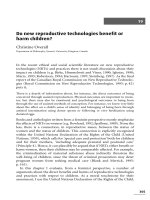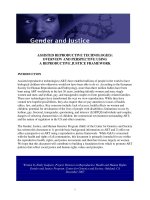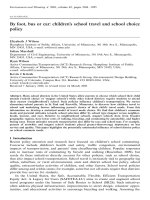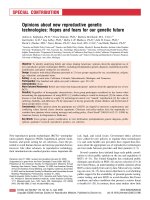Do new reproductive technologies benefit or harm CHILDREN
Bạn đang xem bản rút gọn của tài liệu. Xem và tải ngay bản đầy đủ của tài liệu tại đây (162.39 KB, 16 trang )
19
Do new reproductive technologies benefit or
harm children?
Christine Overall
Department of Philosophy, Queen’s University, Kingston, Canada
In the recent ethical and social scientiWc literature on new reproductive
technologies (NRTs) and practices there is not much discussion about their
impact on children (e.g. Birke, Himmelweit and Vines, 1990; Iglesias, 1990;
Marrs, 1993; Robertson, 1994; Hartouni, 1997; Steinberg, 1997). As the Wnal
report of the Canadian Royal Commission on New Reproductive Technolo-
gies (Royal Commission on New Reproductive Technologies, 1993: p. 42)
puts it,
There is a dearth of information about, for instance, the direct outcomes of being
conceived through assisted reproduction. Physical outcomes are important to moni-
tor, but there may also be emotional and psychological outcomes to being born
through the use of assisted methods of conception. For instance, we know very little
about the eVect on a child’s sense of identity and belonging of being born through
assisted insemination using donor sperm or following in vitro fertilisation using
donated eggs.
Books and anthologies written from a feminist perspective mostly emphasize
the eVects of NRTs on women (e.g. Rowland, 1992; Spallone, 1989). None the
less, there is a connection, in reproductive issues, between the status of
women and the status of children. This connection is explicitly recognized
within the United Nations Declaration of the Rights of the Child (United
Nations, 1959), which calls for ‘special care and protection’ both for children
and for their mothers, ‘including adequate prenatal and postnatal care’
(Principle 4). Hence, it can plausibly be argued that if NRTs either beneWtor
harm women, then their children may be comparably aVected. For example,
the criminalization of maternal substance abuse indirectly threatens the
well-being of children, since the threat of criminal prosecution may deter
pregnant women from seeking medical care (Blank and Merrick, 1995:
p. 165).
In this chapter I evaluate, from a feminist perspective, a number of
arguments about the direct beneWts and harms of reproductive technologies
and practices with respect to children. As a moral touchstone for their
assessment, I use the United Nations Declaration of the Rights of the Child,
305
which sets forth, in a reasonably clear and uncontroversial fashion, some
basic and essential moral entitlements for children everywhere, entitlements
that are widely acknowledged, even if they are not always acted upon.
I shall conWne my discussion to the western world, since that is the context
in which most of the arguments on both sides have been advanced. For the
purposes of this chapter I deWne a ‘child’ as a human oVspring, from the time
of birth up until the end of adolescence. For reasons I shall not explore here, I
do not regard a human embryo or fetus as an infant or child; hence I reject the
approach taken, for example, by Jerome Lejeune, who claims, in the title of
one of his papers, that ‘Test Tube Babies are Babies’ (Lejeune, 1992). None
the less, what is done to embryos and fetuses obviously can aVect the children
they may become. For this reason, the treatment of embryos and fetuses can
be highly relevant to – although it is not identical with – the issue of the
treatment of children.
Alleged benefits of NRTs and practices
It is important to notice that NRTs and practices are rarely defended in terms
of arguments about direct alleged beneWts for children. The focus of argu-
ment is almost always on potential parents, both women and men, and what
they will receive. However, there are a few recurrent claims about the beneWts
of NRTs to children that deserve attention. Three main beneWts are repeat-
edly cited: existence itself; loving, motivated, prosperous parents; and the
avoidance of disabilities.
Existence itself
One prominent argument is that technologies such as IVF (in vitro fertiliz-
ation) are a beneWttooVspring since without the technologies, some children
wouldn’t exist – even if their existence includes physical or psychological
health problems and/or disabilities. Existence itself is a beneWt conferred by
NRTs upon some lucky children. Thus, John Robertson, a prominent de-
fender of the use of NRTs, argues that however diYcult the problems may be
arising from a life created through reproductive technology, that life is
unlikely ever to be so bad as to be not worth living (Robertson, 1994: p. 76).
He states, ‘Whatever psychological or social problems arise, they hardly rise
to the level of severe handicap or disability that would make the child’s very
existence a net burden, and hence a wrongful life’ (Robertson, 1994: p. 122).
How should we assess this argument? Thomas H. Murray points out that if
it is accepted without analysis, then virtually no ‘novel method of bringing
children into the world’ could be morally condemned (Murray, 1996: p. 37).
The argument implies that criticizing a reproductive technology requires
306 C. Overall
showing that the children thus created would have been better oV never
having been born. Of course it seems true that being alive is usually good; I
have little doubt that most children created through NRTs and practices are
glad to be alive. Still, this argument should not be allowed to trump all other
evidence about possible harms generated by reproductive technologies.
For it would be a moral and conceptual mistake to assume that there are
children who would have missed out on a beneWt – life – if not for NRTs. It is
not as if children exist in a limbo, waiting to be given the opportunity to live
via NRTs. Never having existed would not make some hypothetical child
worse oV; there is no child to harm (ParWt, 1984: p. 487). So, even if coming
into existence is a type of beneWt, failing to come into existence is not a harm.
Having life is the precondition that makes all other beneWts – and harms –
possible. If a child suVers illness or disabilities because of the circumstances of
his or her conception or prenatal existence, then we seem to have harmed
him or her, in the process of beneWting him or her by causing his or her
existence. It is arguable that every person has an interest in possessing a
healthy, non-disabled body. If the damages incurred at conception are
suYciently great, there seems to be virtually no beneWt to the child at all.
I conclude that, from a perspective before conception of a child, life is not a
beneWt, since there is no one to beneWt; only from the perspective after
conception has occurred is life arguably a beneWt – and then, only if the life is
not heavily damaged through the process of conception itself. Causing
someone to exist is not a beneWt, since there is no one to beneWt; but once the
person exists, she or he has life, which is usually a good thing.
Loving, motivated, prosperous parents
A second alleged beneWt claimed for NRTs is based on the ostensible charac-
teristics of the parents. Prospective parents who use NRTs are often prosper-
ous, seem really to want children, are in some instances supposedly assessed
for stability, and are ready to have children. More simply, the claim is that
NRTs beneWt (potential) parents, who want children (Snowden and Mitchell,
1983: p. 76; Macklin, 1994: p. 56) and are pleased to have them; hence they
indirectly beneWt the resulting child.
This argument usually takes its most explicit form in the context of debates
about so-called surrogate motherhood, or what I prefer to call contract
pregnancy, where the claim is made that the children resulting from the
contract receive all the beneWts of life within middle-class or wealthy families,
who are equipped to provide the material, social and intellectual privileges
seldom attained in working-class families. Thus, the American Fertility
Society (1990: p. 312) claims,
Even if there are psychological risks, most infertile couples who go through with a
307Do new reproductive technologies benefit or harm children?
reproduction arrangement that involves a third party do so as a last resort. In some
cases, their willingness to make sacriWces to have a child may testify to their worthi-
ness as loving parents. A child conceived through surrogate motherhood may be born
into a much healthier climate than a child whose birth was unplanned.
However, this argument is not persuasive. Its classist bias is immediately
obvious: the assumption is that life in a middle- or upper-class family is
inevitably a greater beneWt to a child than life in a working-class family. This
assumption worked to the disadvantage of Mary Beth Whitehead, a working-
class woman, when she sought custody of her biological daughter, so-called
‘Baby M’, whom she contracted to create for William Stern, a well-oV
professional.
More signiWcantly, perhaps, the argument assumes that would-be parents
who resort to NRTs and practices are especially motivated and beneWcent
toward their subsequent children. However, as I shall suggest later, there are
also reasons to be concerned about the motives and goals of these people.
And, at the very least, there is no empirical evidence that I know of to suggest
that they make better parents than those who do not use technology in
reproduction.
Avoidance of disabilities
The third main beneWt claimed for some NRTs and practices is that they can
help to reduce or eliminate disabilities in children (Tauer, 1990: p. 75). For
example, Deborah Kaplan (1994: p. 50) lists several possible beneWts to
children of prenatal diagnosis (PND) and treatment. First:
Prevention or amelioration of the disability using methods such as treatment through
dietary changes or supplements for the mother or infant; prenatal treatment of the
fetus through pharmaceutical or surgical interventions; other forms of treatment or
therapy for the infant that occur after prenatal diagnosis.
Second:
Prevention of family disruption through prenatal preparation by family members.
This can entail obtaining information about the diagnosed condition and its conse-
quences through reading or through talking to families who have children with
similar disabilities or to adults who live with the disability themselves. It may also
include such means as Wnding out about available public or private resources or forms
of assistance, purchasing equipment, or making home modiWcations.
So, the suggestion is that the technologies of prenatal diagnosis beneWt
children directly through the prevention and amelioration of disabilities, and
indirectly, by assisting parents. These claims seem justiWed.
However, it would be a mistake to accept the related claim, made by some,
that NRTs produce better, or even perfect, babies (Spallone, 1989: pp. 113,
308 C. Overall
117; Snowden and Mitchell, 1983: p. 77); that, for example, babies generated
by IVF or donor insemination (DI) using sperm from gifted fathers are
smarter or prettier (Scutt, 1990: p. 285). There is no clear evidence to support
these claims. And there are reasons to be cautious about them, since, as I shall
later show, they betray a eugenicist agenda.
Possible harms of NRTs and practices
I turn now to those arguments that claim that NRTs and practices harm
children. These claims arise from asking, what kind of future do NRTs give to
children, speciWcally to those born as a result of them, but also to other
children who may be aVected by the attitudes that NRTs foster?
Some claims about harms to children of NRTs are not plausible. For
example, I am unpersuaded of the necessity, insisted upon by some Roman
Catholic critics of NRTs, of ‘naturalness’ in reproduction, and of marriage as
the ideal or the only moral site for the raising of children (Iglesias, 1990:
p. 159). For if naturalness is the criterion of moral acceptability, then many
medical interventions are morally unjustiWed. If marriage is the criterion, it is
hard to account for the growing number, and evident success, of common-
law relationships in which children are being born and raised.
Among the problems of NRTs for children that I think are serious are Wve
that deserve special examination: the emphasis on a genetic link with one’s
oVspring and the possibility of eugenicist tendencies in the application of
reproductive technologies; the sexism of sex preselection and the hetero-
sexism and racism of selective access to NRTs; the possible dangers to
children’s health of some reproductive techniques; the selling of children
through contract pregnancy arrangements; and the violation of the right of
children who are created through sperm or egg ‘donation’ or contract
motherhood to know the identity of their progenitors.
Genetic links and eugenicist tendencies
The motive behind many new reproductive technologies and related prac-
tices (e.g. contract pregnancy and IVF for male subfertility problems) is the
goal of obtaining, particularly for the potential father, a genetic link with
one’s oVspring. But this emphasis on a genetic link is thought by some
commentators to reinforce a cultural notion of the child as possession, as a
form of property. When producing (better) babies is treated as a business
opportunity, infants are seen as commodities, as consumer goods marketed
to the infertile (Rowland, 1992: pp. 3–4, 243).
Such a view of children is arguably incompatible with Principle 2 of the
United Nations Declaration of the Rights of the Child (United Nations,
309Do new reproductive technologies benefit or harm children?
1959), which mandates ‘opportunities and facilities’ to enable children ‘to
develop physically, mentally, morally, spiritually, and socially in a healthy
and normal manner and in conditions of freedom and dignity’, and also with
the recognition in Principle 6 that children need ‘love and understanding’ for
‘the full and harmonious development’ of their personalities.
The result of the longing for children, especially children of a certain kind,
a longing which, to some extent, NRTs exacerbate, could be the generation of
performance pressures on children to live up to parental expectations. Such
pressures seem inconsistent with the spirit of Principle 7 of the United
Nations Declaration of the Rights of the Child, which states that the ‘best
interests of the child shall be the guiding principle of those responsible for his
education and guidance.’
A related concern, frequently expressed in the literature by feminist theor-
ists, involves worries about eugenicist tendencies generated by the use of
techniques of prenatal diagnosis (e.g. Birke et al., 1990: p. 184; Bopp, 1990:
pp. 205–7). The concern is both for general eVects on children (Blank and
Merrick, 1995: p. 101), with the fear that the quest to improve the characteris-
tics of infants may cause psychological hardship and exacerbate the com-
modiWcation of children, and also, more speciWcally, for the negative impact
of the existence and use of prenatal diagnosis on children with disabilities,
who may be made to feel that they are mistakes who should never have
existed (Kaplan, 1994; Murray, 1996: p. 132), and who may be made less
welcome within this culture.
In response to the latter claim, however, the Canadian Royal Commission
on New Reproductive Technologies argues that it ‘does not seem likely’ that
‘funding for PND will aVect the funds available for social support for people
with disabilities’ (Royal Commission on New Reproductive Technologies,
1993: p. 800). Their reason is that PND has little aVect on the incidence of
disabilities (Royal Commission, 1993: p. 799), and people who seek PND
may already have a child with disabilities whom they love: ‘[E]vidence
suggests that in countries where PND is practised, there is greater rather than
less interest in the welfare of people with disabilities as a result of increased
medical and social awareness of their needs and rights’ (Royal Commission,
1993: p. 802).
My own view is that it is not inevitable or necessary that the use of PND for
fetal impairment will lead to the devaluing of children with disabilities.
Indeed, the informal evidence suggests that even while the use of PND is
growing, attempts to integrate people with disabilities within ‘mainstream’
culture, while at the same time providing for and supporting their diVeren-
ces, are also growing. Although I am concerned about the potential com-
modiWcation of children caused by the use of NRTs, I agree with Ruth
Chadwick, who argues, ‘If we say that it is better, all things considered, to
produce a child who is not handicapped rather than one who is, this does not
310 C. Overall









